Abstract
1. The role of tumour necrosis factor-alpha (TNF-alpha) in fever is controversial. Some studies have indicated that TNF-alpha acts as a cryogen to inhibit fever, while others suggest that TNF-alpha is an endogenous pyrogen which mediates fever. The majority of studies in experimental animals supporting a cryogenic action have been conducted using human (h)TNF-alpha, which has been shown to bind only to one (p55) of the two TNF-alpha receptors in rodents. 2. The aim of the present investigation was to study the role of TNF-alpha in fever by comparing effects of hTNF-alpha, which binds only to the p55 receptor, with those of murine (m) TNF-alpha, which binds to both p55 and p75 TNF-alpha receptors, and to investigate the relationship between TNF-alpha and interleukin-1 (IL-1), an important endogenous pyrogen. 3. Injection of hTNF-alpha (0.3-10 micrograms kg-1, i.p.) had no effect on core temperature in conscious rats (measured by remote radiotelemetry), whereas mTNF-alpha (3 micrograms kg-1) induced fever which was maximal 1 h after the injection (38.2 +/- 0.2 degrees C compared to 37.3 +/- 0.1 degrees C in controls). Intracerebroventricular (i.c.v.) administration of either form of TNF-alpha elicited dose-dependent fever at doses higher than 0.12 microgram kg-1. 4. Peripheral injection of hIL-1 beta (1 microgram kg-1) resulted in fever (38.3 +/- 0.2 degree C compared to 37.2 +/- 0.1 degrees C in controls at 2 h), which was significantly attenuated (P < 0.01) by co-administration of a sub-pyrogenic dose of hTNF-alpha (1 microgram kg-1), but was unaffected by co-administration of mTNF-alpha (0.1 or 0.3 microgram kg-1, i.p.). In contrast, intracerebroventricular (i.c.v.) co-administration of a sub-pyrogenic dose (0.12 microgram kg-1) of hTNF-alpha did not attenuate fever induced by intraperitoneal (i.p.) injection of IL-1 beta, and sub-pyrogenic dose (0.12 microgram kg-1, i.c.v.) of mTNF-alpha significantly prolonged the febrile response to IL-1 beta. Pretreatment of animals with anti-TNF-alpha antiserum (i.c.v.) did not affect the febrile response to systemic IL-1 beta. 5. Animals injected i.p. with a pyrogenic dose of mTNF-alpha developed fever (38.2 +/- 0.2 degrees C compared to 37.3 +/- 0.1 degrees C in controls 2 h after the injection) that was completely abolished by peripheral administration of IL-1ra (2 mg kg-1, P < 0.001), while i.c.v. administration of IL-1ra (400 micrograms/rat) did not affect mTNF-alpha-induced fever. 6. These data indicate that endogenous TNF-alpha is probably a pyrogen and that previous results suggesting cryogenic actions of TNF-alpha resulted from the use of a heterologous protein in the rat. The markedly contrasting effects of mTNF-alpha and TNF-alpha could result from different interactions with the two TNF-alpha receptor subtypes. The data also suggest that fever induced by exogenous TNF-alpha is mediated via release of IL-1 beta in peripheral tissues, but not in the brain.
Full text
PDF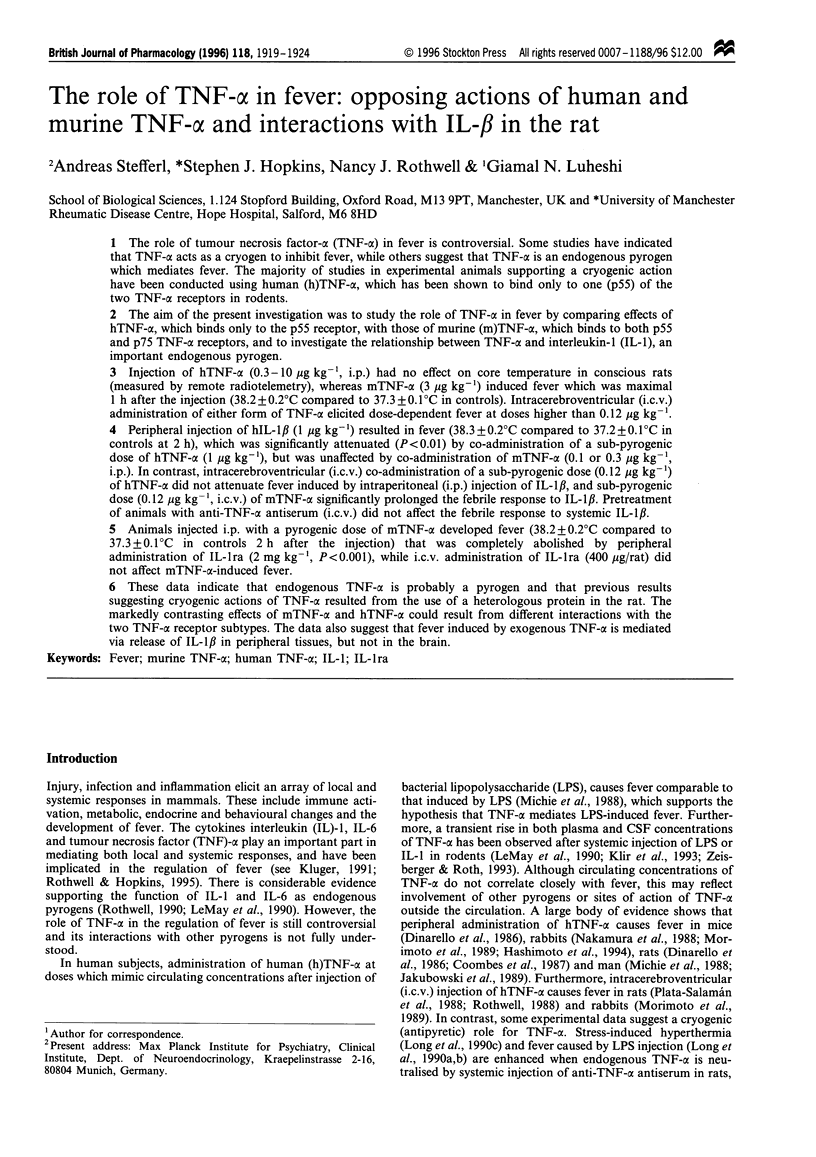
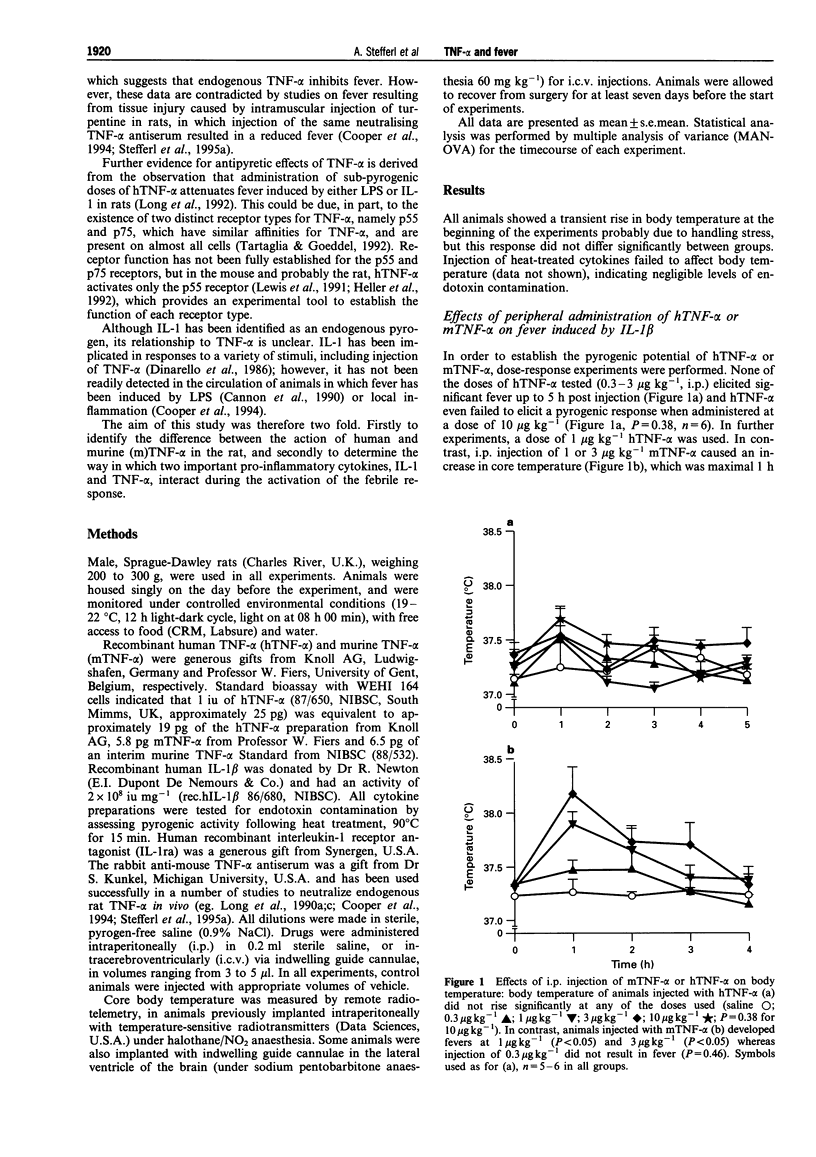
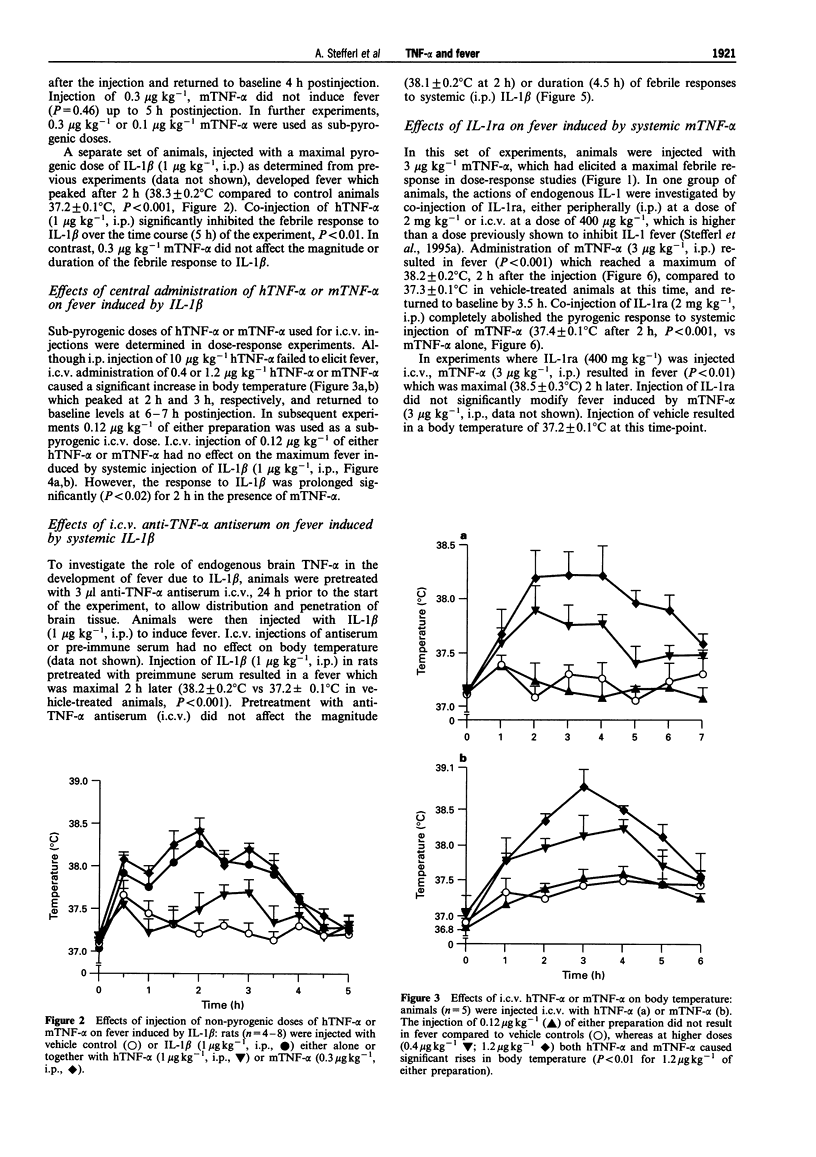
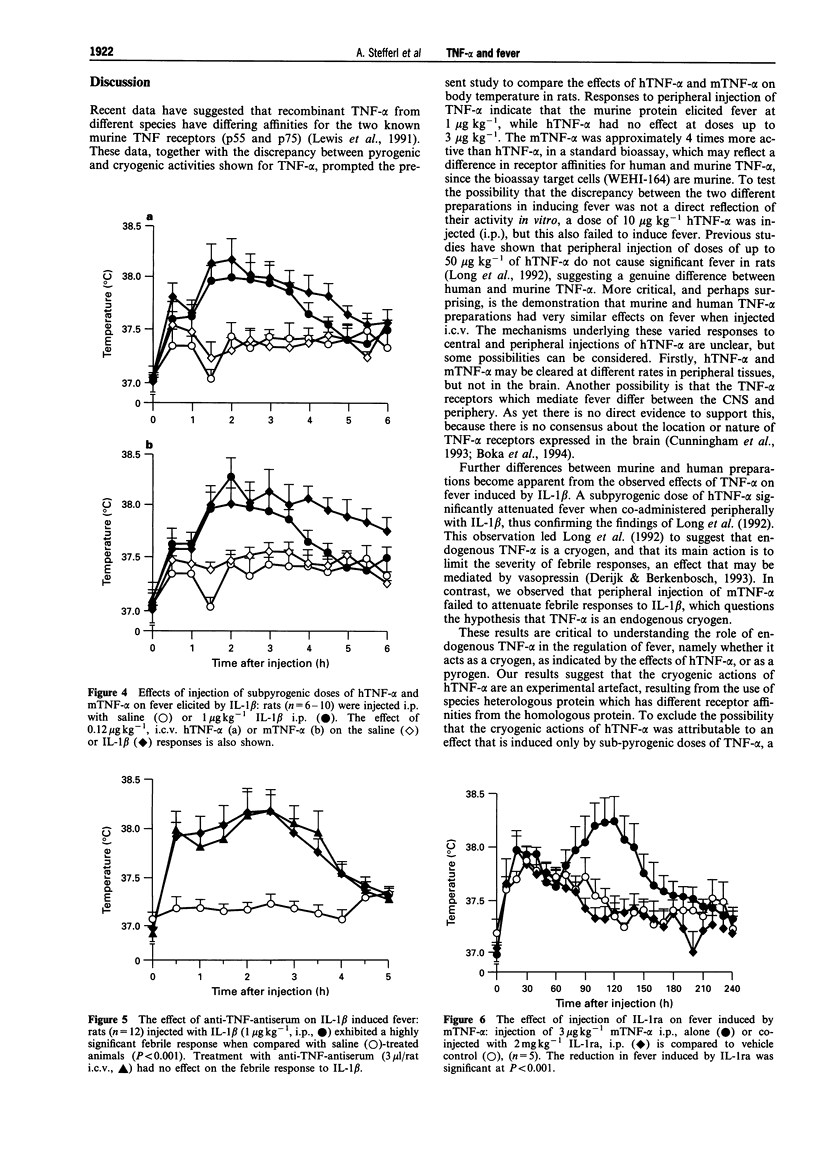
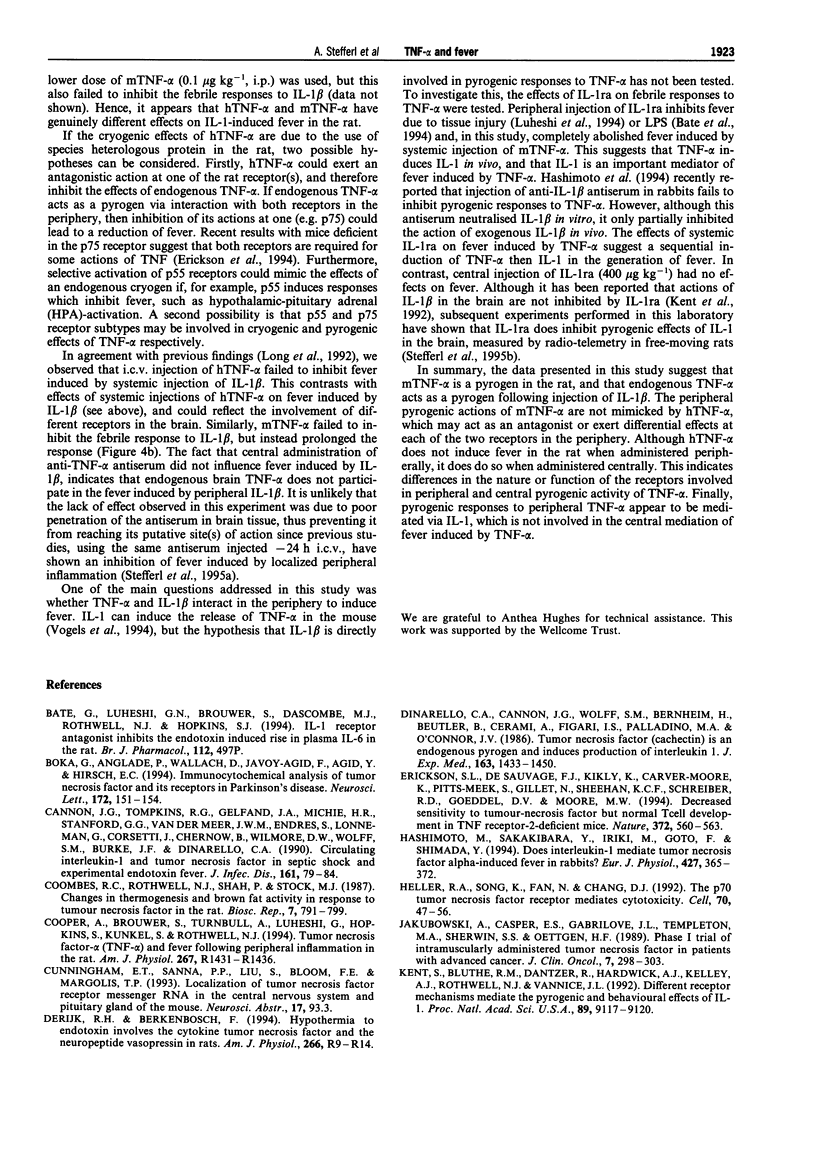
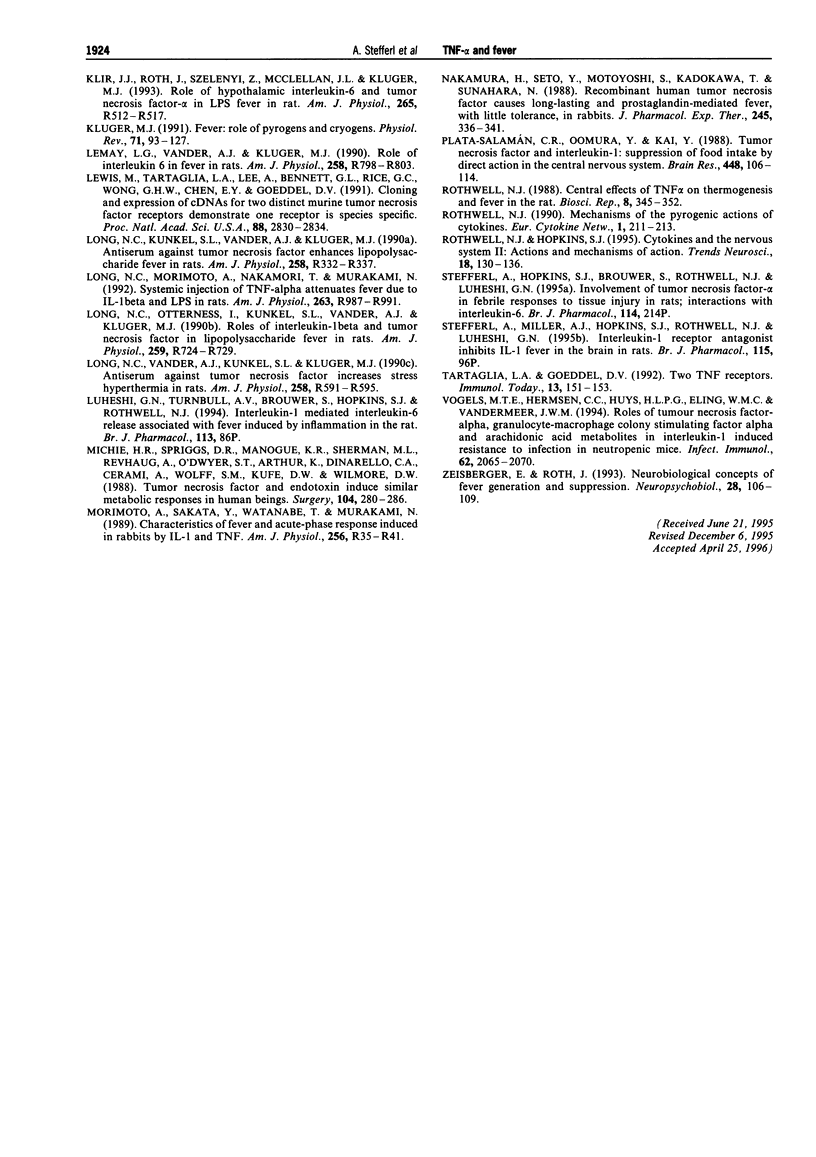
Selected References
These references are in PubMed. This may not be the complete list of references from this article.
- Boka G., Anglade P., Wallach D., Javoy-Agid F., Agid Y., Hirsch E. C. Immunocytochemical analysis of tumor necrosis factor and its receptors in Parkinson's disease. Neurosci Lett. 1994 May 19;172(1-2):151–154. doi: 10.1016/0304-3940(94)90684-x. [DOI] [PubMed] [Google Scholar]
- Cannon J. G., Tompkins R. G., Gelfand J. A., Michie H. R., Stanford G. G., van der Meer J. W., Endres S., Lonnemann G., Corsetti J., Chernow B. Circulating interleukin-1 and tumor necrosis factor in septic shock and experimental endotoxin fever. J Infect Dis. 1990 Jan;161(1):79–84. doi: 10.1093/infdis/161.1.79. [DOI] [PubMed] [Google Scholar]
- Coombes R. C., Rothwell N. J., Shah P., Stock M. J. Changes in thermogenesis and brown fat activity in response to tumour necrosis factor in the rat. Biosci Rep. 1987 Oct;7(10):791–799. doi: 10.1007/BF01116752. [DOI] [PubMed] [Google Scholar]
- Cooper A. L., Brouwer S., Turnbull A. V., Luheshi G. N., Hopkins S. J., Kunkel S. L., Rothwell N. J. Tumor necrosis factor-alpha and fever after peripheral inflammation in the rat. Am J Physiol. 1994 Dec;267(6 Pt 2):R1431–R1436. doi: 10.1152/ajpregu.1994.267.6.R1431. [DOI] [PubMed] [Google Scholar]
- Dinarello C. A., Cannon J. G., Wolff S. M., Bernheim H. A., Beutler B., Cerami A., Figari I. S., Palladino M. A., Jr, O'Connor J. V. Tumor necrosis factor (cachectin) is an endogenous pyrogen and induces production of interleukin 1. J Exp Med. 1986 Jun 1;163(6):1433–1450. doi: 10.1084/jem.163.6.1433. [DOI] [PMC free article] [PubMed] [Google Scholar]
- Erickson S. L., de Sauvage F. J., Kikly K., Carver-Moore K., Pitts-Meek S., Gillett N., Sheehan K. C., Schreiber R. D., Goeddel D. V., Moore M. W. Decreased sensitivity to tumour-necrosis factor but normal T-cell development in TNF receptor-2-deficient mice. Nature. 1994 Dec 8;372(6506):560–563. doi: 10.1038/372560a0. [DOI] [PubMed] [Google Scholar]
- Hashimoto M., Sakakibara Y., Iriki M., Goto F., Shimada Y. Does interleukin-1 mediate tumour necrosis factor alpha-induced fever in rabbits? Pflugers Arch. 1994 Jun;427(3-4):365–372. doi: 10.1007/BF00374546. [DOI] [PubMed] [Google Scholar]
- Heller R. A., Song K., Fan N., Chang D. J. The p70 tumor necrosis factor receptor mediates cytotoxicity. Cell. 1992 Jul 10;70(1):47–56. doi: 10.1016/0092-8674(92)90532-h. [DOI] [PubMed] [Google Scholar]
- Jakubowski A. A., Casper E. S., Gabrilove J. L., Templeton M. A., Sherwin S. A., Oettgen H. F. Phase I trial of intramuscularly administered tumor necrosis factor in patients with advanced cancer. J Clin Oncol. 1989 Mar;7(3):298–303. doi: 10.1200/JCO.1989.7.3.298. [DOI] [PubMed] [Google Scholar]
- Kent S., Bluthe R. M., Dantzer R., Hardwick A. J., Kelley K. W., Rothwell N. J., Vannice J. L. Different receptor mechanisms mediate the pyrogenic and behavioral effects of interleukin 1. Proc Natl Acad Sci U S A. 1992 Oct 1;89(19):9117–9120. doi: 10.1073/pnas.89.19.9117. [DOI] [PMC free article] [PubMed] [Google Scholar]
- Klir J. J., Roth J., Szelényi Z., McClellan J. L., Kluger M. J. Role of hypothalamic interleukin-6 and tumor necrosis factor-alpha in LPS fever in rat. Am J Physiol. 1993 Sep;265(3 Pt 2):R512–R517. doi: 10.1152/ajpregu.1993.265.3.R512. [DOI] [PubMed] [Google Scholar]
- Kluger M. J. Fever: role of pyrogens and cryogens. Physiol Rev. 1991 Jan;71(1):93–127. doi: 10.1152/physrev.1991.71.1.93. [DOI] [PMC free article] [PubMed] [Google Scholar]
- LeMay L. G., Vander A. J., Kluger M. J. Role of interleukin 6 in fever in rats. Am J Physiol. 1990 Mar;258(3 Pt 2):R798–R803. doi: 10.1152/ajpregu.1990.258.3.R798. [DOI] [PubMed] [Google Scholar]
- Lewis M., Tartaglia L. A., Lee A., Bennett G. L., Rice G. C., Wong G. H., Chen E. Y., Goeddel D. V. Cloning and expression of cDNAs for two distinct murine tumor necrosis factor receptors demonstrate one receptor is species specific. Proc Natl Acad Sci U S A. 1991 Apr 1;88(7):2830–2834. doi: 10.1073/pnas.88.7.2830. [DOI] [PMC free article] [PubMed] [Google Scholar]
- Long N. C., Kunkel S. L., Vander A. J., Kluger M. J. Antiserum against tumor necrosis factor enhances lipopolysaccharide fever in rats. Am J Physiol. 1990 Feb;258(2 Pt 2):R332–R337. doi: 10.1152/ajpregu.1990.258.2.R332. [DOI] [PubMed] [Google Scholar]
- Long N. C., Morimoto A., Nakamori T., Murakami N. Systemic injection of TNF-alpha attenuates fever due to IL-1 beta and LPS in rats. Am J Physiol. 1992 Nov;263(5 Pt 2):R987–R991. doi: 10.1152/ajpregu.1992.263.5.R987. [DOI] [PubMed] [Google Scholar]
- Long N. C., Otterness I., Kunkel S. L., Vander A. J., Kluger M. J. Roles of interleukin 1 beta and tumor necrosis factor in lipopolysaccharide fever in rats. Am J Physiol. 1990 Oct;259(4 Pt 2):R724–R728. doi: 10.1152/ajpregu.1990.259.4.R724. [DOI] [PubMed] [Google Scholar]
- Long N. C., Vander A. J., Kunkel S. L., Kluger M. J. Antiserum against tumor necrosis factor increases stress hyperthermia in rats. Am J Physiol. 1990 Mar;258(3 Pt 2):R591–R595. doi: 10.1152/ajpregu.1990.258.3.R591. [DOI] [PubMed] [Google Scholar]
- Michie H. R., Spriggs D. R., Manogue K. R., Sherman M. L., Revhaug A., O'Dwyer S. T., Arthur K., Dinarello C. A., Cerami A., Wolff S. M. Tumor necrosis factor and endotoxin induce similar metabolic responses in human beings. Surgery. 1988 Aug;104(2):280–286. [PubMed] [Google Scholar]
- Morimoto A., Sakata Y., Watanabe T., Murakami N. Characteristics of fever and acute-phase response induced in rabbits by IL-1 and TNF. Am J Physiol. 1989 Jan;256(1 Pt 2):R35–R41. doi: 10.1152/ajpregu.1989.256.1.R35. [DOI] [PubMed] [Google Scholar]
- Nakamura H., Seto Y., Motoyoshi S., Kadokawa T., Sunahara N. Recombinant human tumor necrosis factor causes long-lasting and prostaglandin-mediated fever, with little tolerance, in rabbits. J Pharmacol Exp Ther. 1988 Apr;245(1):336–341. [PubMed] [Google Scholar]
- Plata-Salamán C. R., Oomura Y., Kai Y. Tumor necrosis factor and interleukin-1 beta: suppression of food intake by direct action in the central nervous system. Brain Res. 1988 May 10;448(1):106–114. doi: 10.1016/0006-8993(88)91106-7. [DOI] [PubMed] [Google Scholar]
- Rothwell N. J. Central effects of TNF alpha on thermogenesis and fever in the rat. Biosci Rep. 1988 Aug;8(4):345–352. doi: 10.1007/BF01115225. [DOI] [PubMed] [Google Scholar]
- Rothwell N. J., Hopkins S. J. Cytokines and the nervous system II: Actions and mechanisms of action. Trends Neurosci. 1995 Mar;18(3):130–136. doi: 10.1016/0166-2236(95)93890-a. [DOI] [PubMed] [Google Scholar]
- Rothwell N. J. Mechanisms of the pyrogenic actions of cytokines. Eur Cytokine Netw. 1990 Oct-Nov;1(4):211–213. [PubMed] [Google Scholar]
- Tartaglia L. A., Goeddel D. V. Two TNF receptors. Immunol Today. 1992 May;13(5):151–153. doi: 10.1016/0167-5699(92)90116-O. [DOI] [PubMed] [Google Scholar]
- Vogels M. T., Hermsen C. C., Huys H. L., Eling W. M., van der Meer J. W. Roles of tumor necrosis factor alpha, granulocyte-macrophage colony-stimulating factor, platelet-activating factor, and arachidonic acid metabolites in interleukin-1-induced resistance to infection in neutropenic mice. Infect Immun. 1994 May;62(5):2065–2070. doi: 10.1128/iai.62.5.2065-2070.1994. [DOI] [PMC free article] [PubMed] [Google Scholar]
- Zeisberger E., Roth J. Neurobiological concepts of fever generation and suppression. Neuropsychobiology. 1993;28(1-2):106–109. doi: 10.1159/000119010. [DOI] [PubMed] [Google Scholar]


